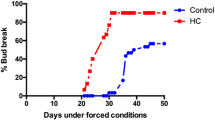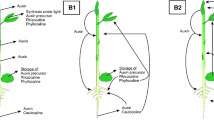Abstract
Cytokinins induced haustoria formation in excised 10-mm segments ofCuscuta vine, the subapical 25-to-50-mm region being most responsive, producing a mean of 4–6 haustoria per segment. The order of effectiveness of cytokinins continuously applied (72 h) was 6-benzylaminopurine (BA) ⩾ isopentenyladenine (iP) ≫ zeatin (Z). Ribosides of BA and Z were as effective as the bases, whereas riboside of iP ([9R]iP) was half as effective as iP. Haustoria induction was influenced by weather and seasonal conditions at the time of vine collection; materials obtained on warm, sunny days responded better than those obtained on rainy, cloudy, or cool days. Haustoria were induced equally well all around the segment, and no thigmostimulus was needed for induction. p ]A 10-min pulse of 100 μM BA induced half as many haustoria as a 60-min pulse or continuous application of BA. White light inhibited haustoria induction elicited by a short (30-min) pulse of BA, whereas a longer (120-min) BA application overcame this light inhibition. Auxins (IAA or NAA, 1–10 μM), gibberellin (GA3, 1–10 μM), ethylene (as ethrel, 10–100 μM), and abscisic acid (ABA, 100 μM) were individually inhibitory (60–80%) with respect to haustoria induction when given continuously with 50 μM BA. A 60-min pulse of auxins (10 μM), GA3 (100 μM), or ethrel (10 μM), given at various time intervals during or after a 60-min pulse of 100 μM BA, showed that inhibition was maximal (70–95%) between 4 and 16 h of BA application and negligible (GA3) or much reduced (auxin, ethrel) at 20 h, indicating a “commitment” to haustoria formation by this time.
Similar content being viewed by others
References
Goran S (1982) Cytokinins as inhibitors of root growth. Physiol Plant 56:500–506
Gupta A, Singh M (1985) Mechanism of parasitism byCuscuta reflexa: Distribution of cytokinins in different regions of the parasite vine. Physiol Plant 63:76–78
Houck DF, La Motte CE (1977) Primary phloem regeneration without concomitant xylem regeneration: Its hormone control inColeus. Am J Bot 64:799–809
Ihl B, Jacob F, Sembdner G (1984) Studies onCuscuta reflexa ROXB. V. The level of endogenous hormones in the parasite,Cuscuta reflexa and its host,Vicia faba L., and a suggested role in the transfer of nutrients from host to parasite. Plant Growth Regul 2:77–90
Jacob F, Strobel U, Engelbrecht L, Schulz W (1975) Studies onCuscuta reflexa ROXB. III. Zur Frage einer cytokininabhangigen Nahrstoffaufnahme. Biochem Physiol Pflanzen 168:349–359
Letham DS (1978) Cytokinins. In: Letham DS, Goodwin PB, Higgins TJV (eds), Phytohormones and related compounds: A comprehensive treatise, Vol 1. Elsevier North Holland, Amsterdam, pp 205–263
Letham DS, Palni LMS, Tao G-Q, Gollnow BI, Bates CM (1983) Regulators of cell division in plant tissues. XXIX. The activities of cytokinin glucosides and alanine conjugates in cytokinin bioassays. J Plant Growth Regul 2:103–115
Mahadevan S (1983) How the hormone controls the parasite. New Sci 98:164–167
Paliyath G, Lakshmi Murthy HK, Maheshwari R, Mahadevan S (1979) Cytokinin induced haustoria formation inCuscuta. Abstract 223, 10th Int Conf Plant Growth Subst, Madison, WI, July 1979
Paliyath G, Maheshwari R, Mahadevan S (1978) Initiation of haustoria inCuscuta by cytokinin application. Curr Sci 47:427–429
Pillay I, Railton JD (1983) Complete release of axillary buds from apical dominance in intact light grown seedlings ofPisum sativum L. following a single application of cytokinin. Plant Physiol 71:972–974
Rajagopal I, Ramasubramanian TS, Paliyath G, Mahadevan S (1988) Hormones andCuscuta development: Interaction of cytokinin and indole-3-acetic acid in the growth and curvature of subapical stem segments. J Plant Growth Regul 7:121–132
Ramasubramanian TS, Mahadevan S (1985) Cytokinins inCuscuta: Quantitation using HPLC linked radioimmunoassay (RIA) and their role in haustoria formation. Abstract 0363, 12th Int Conf Plant Growth Subst, Heidelberg, West Germany, August 1985
Spiess LD (1975) Comparative activity of isomers of zeatin and ribosyl-zeatin onFunaria hygrometrica. Plant Physiol 55:583–585
Tanimoto S, Harada H (1982) Studies on the initial process of adventitious bud differentiation inTorenia stem segments culturedin vitro. I. Effects of cytokinin. Biochem Physiol Pflanzen 177:222–228
Tsivion Y (1978) Possible role of cytokinins in non-specific recognition of a host and in early growth of haustoria in the parasitic plantCuscuta campestris. Bot Gaz 139:27–31
Turnbull CGN, Hanke DE (1985) The control of bud dormancy in potato tubers. Evidence for the primary role of cytokinins and a seasonal pattern of changing sensitivity in cytokinin. Planta 165:359–365
Vanderhoef LN, Stahl CA (1975) Separation of two responses to auxin by means of cytokinin inhibition. Proc Natl Acad Sci USA 72:1822–1825A0443011 00002 CS-SPJRNPDF [HEADSUP]
Author information
Authors and Affiliations
Rights and permissions
About this article
Cite this article
Ramasubramanian, T.S., Paliyath, G., Rajagopal, I. et al. Hormones andCuscuta development: In vitro induction of haustoria by cytokinin and its inhibition by other hormones. J Plant Growth Regul 7, 133–144 (1988). https://doi.org/10.1007/BF02024676
Received:
Accepted:
Issue Date:
DOI: https://doi.org/10.1007/BF02024676




